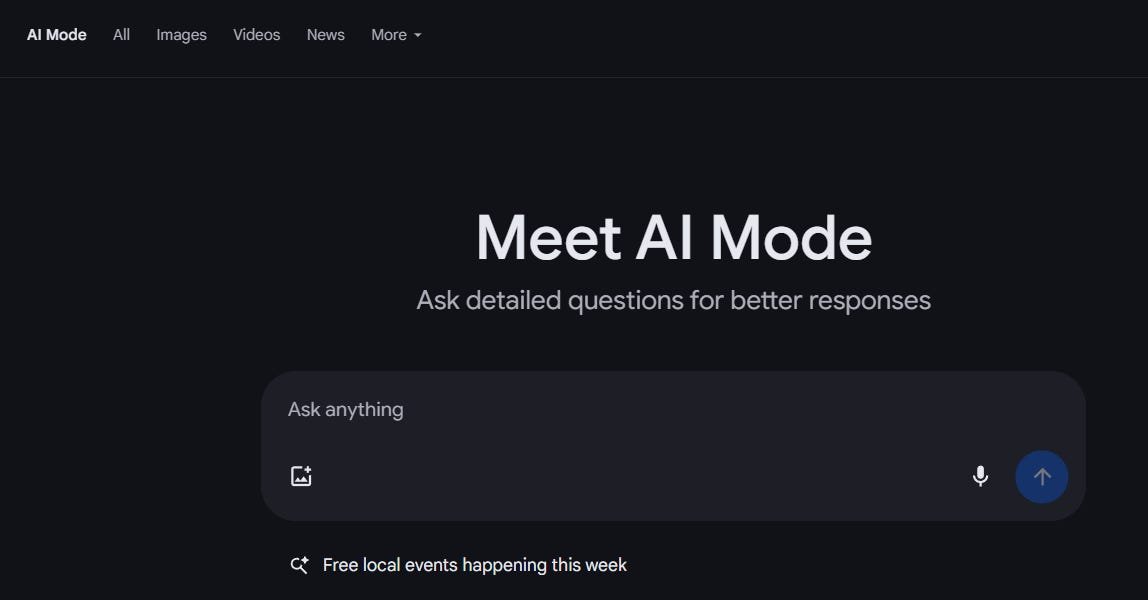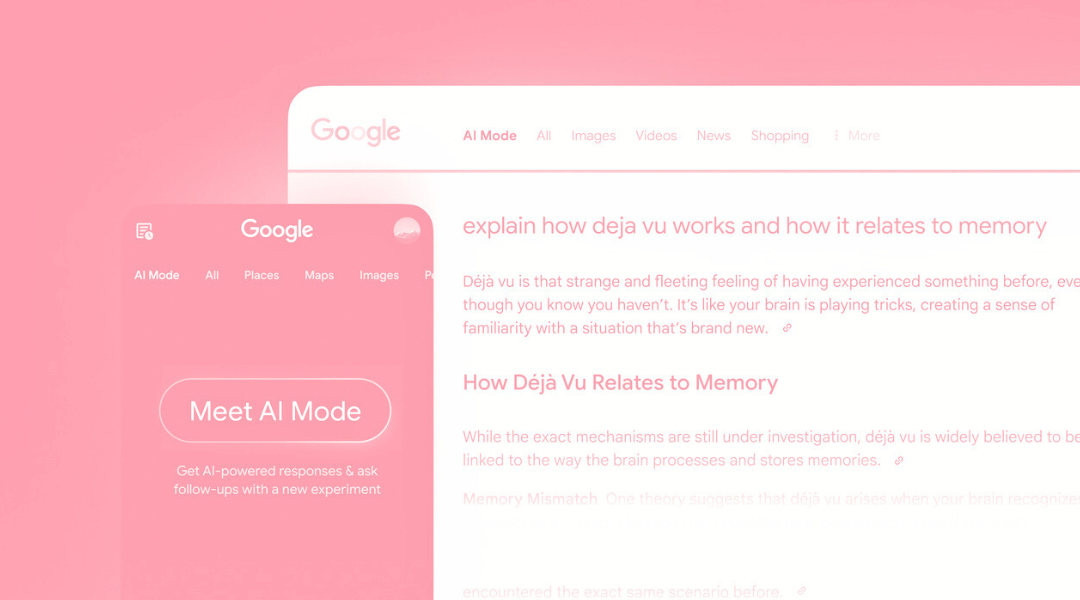Understanding Google’s New “AI Mode”
Google’s “AI Mode” marks a significant advancement in search engine interaction by utilizing Artificial Intelligence to improve search capabilities. It employs Machine Learning, natural language processing (NLP), and deep learning to understand human language nuances, thus interpreting queries beyond mere keyword matching. This allows “AI Mode” to discern the intent behind queries, offering more context-aware results. A key feature is personalized search experiences, where the AI analyzes user behavior to tailor results, enhancing accuracy and relevance over time. Additionally, “AI Mode” integrates with Google’s AI tools like Google Assistant and Google Lens, facilitating dynamic interactions such as voice-activated and visual searches. This integration offers real-time information delivery in engaging formats. Overall, “AI Mode” aims to make search processes more intelligent and responsive, potentially redefining user expectations and setting new standards for future search engine operations.
What is “AI Mode”?
“AI Mode” is a feature by Google that integrates advanced artificial intelligence into its search engine, aiming to enhance user interaction by providing personalized and context-aware responses. It uses machine learning and natural language processing to understand user intent beyond traditional keyword matching, delivering tailored search results. A standout feature of AI Mode is its ability to handle complex, conversational queries, allowing users to ask questions naturally and receive human-like responses. It also uses real-time Data Analysis to provide the most current and relevant answers, continuously refining its algorithms based on user interactions. This innovative approach seeks to make search more intuitive, marking a significant shift from traditional methods and potentially transforming how users access information online.
How Does “AI Mode” Work?
Google’s “AI Mode” revolutionizes search technology by using advanced AI to enhance user interaction and information retrieval. It employs machine learning and natural language processing to provide intuitive, personalized, and context-aware search results. When a user inputs a query, “AI Mode” analyzes it with sophisticated language models that understand intent and nuances, identifying key concepts and relationships. It then accesses Google’s vast web index, using AI-driven ranking algorithms to prioritize results based on relevance and user intent, not just keyword matching. This approach considers context and semantic meaning, surfacing relevant results even if they lack exact search terms. “AI Mode” also incorporates real-time data and personalization, using user behavior and preferences to tailor results. It introduces interactive elements, allowing users to engage with results and ask follow-up questions, creating a conversational search experience. Overall, “AI Mode” transforms search into a dynamic, intuitive process aligned with human information-seeking behavior.
The Impact of “AI Mode” on Search
Google’s “AI Mode” is set to revolutionize online search by enhancing precision and personalization, reshaping user interactions, search results, and business models. Unlike traditional search engines that rely on keyword matching, “AI Mode” uses machine learning to interpret query intent, providing more relevant results and reducing time spent on irrelevant links. This personalization, based on user behavior and preferences, improves user satisfaction and loyalty but raises privacy concerns due to the vast data required. Businesses may need to shift from keyword optimization to focusing on content quality and user engagement as AI better discerns user intent. The advertising landscape will also change, with more personalized ads potentially increasing conversion rates but also competition and costs. Overall, “AI Mode” marks a significant shift in search technology, offering improved user experiences while posing challenges and opportunities in privacy, SEO, and digital marketing.
Changes in Search Algorithms
Google’s “AI Mode” introduces a transformative approach to search algorithms, leveraging advanced AI to enhance search precision and relevance beyond traditional keyword-based paradigms. Key changes include integrating machine learning models that better understand natural language, allowing for more conversational interactions by comprehending context and intent. This marks a shift from the longstanding reliance on keyword matching and link analysis.
“AI Mode” also uses deep learning to adapt over time, refining search contexts and user preferences for personalized experiences. It identifies previously undetectable patterns, improving prediction accuracy. AI now assesses content quality and credibility, focusing on authoritativeness and trustworthiness to combat misinformation and elevate high-quality content in rankings.
Additionally, AI Mode’s multimodal data processing integrates text, images, and videos, offering richer, more diverse search results. Overall, these advancements make search more intuitive, context-aware, and personalized, setting a new standard for information retrieval and potentially redefining traditional search models.

Enhanced User Experience
Google’s new “AI Mode” revolutionizes user experience by enhancing search interactions through advanced artificial intelligence. This mode personalizes search outcomes, aligning them with individual preferences and needs by understanding user query nuances, thus improving satisfaction and engagement. AI Mode excels in processing natural language, allowing users to pose complex questions and receive comprehensive responses, saving time and reducing frustration from irrelevant results. It integrates with other Google services, offering a cohesive ecosystem that anticipates user needs across platforms, such as providing tailored travel suggestions. Dynamic result presentation organizes information visually and interactively, enriching the search experience with multimedia elements. AI Mode continuously learns from user interactions, evolving to better predict needs and preferences, ensuring a personalized and up-to-date search journey. Overall, Google’s AI Mode redefines the user experience by making search more intuitive, relevant, and visually engaging, emphasizing personalization and context in the digital age.
Potential Challenges and Limitations
Google’s “AI Mode” aims to enhance search with personalized, context-aware results but faces challenges that may affect its success. A major concern is potential bias or inaccuracies, as AI systems rely on vast datasets that might contain outdated or biased information, risking skewed results and misinformation (Source 1). Privacy issues also arise, as the mode requires extensive user data, prompting worries about data collection and usage, which could deter users or lead to calls for stricter data protections (Source 2). The complexity of AI algorithms can result in a “black box” effect, reducing transparency and trust, especially if users suspect commercial bias in search results (Source 3). Additionally, AI Mode’s computational demands could increase operational costs and strain infrastructure, potentially limiting sustainability (Source 4). Lastly, user adaptation poses a challenge; if the new features seem too complex or intrusive, users might prefer traditional search methods, hindering AI Mode’s adoption (Source 5). Addressing these issues is crucial for AI Mode’s success.
Why “AI Mode” Could Break Traditional Search
Google’s “AI Mode” marks a major shift in search result generation, potentially disrupting traditional search experiences by leveraging AI for personalized, contextually relevant results. Unlike conventional algorithms focused on keyword matching, “AI Mode” uses machine learning to better understand user intent, offering predictive, tailored results that may reduce reliance on precise queries. This could alter how search results are presented, favoring conversational formats similar to virtual assistants, possibly decreasing traditional click-through rates as users find answers directly within the search interface. Consequently, businesses may need to adapt SEO strategies to cater to AI-driven mechanisms. Additionally, AI’s ability to filter content could streamline searches but risks reinforcing information bubbles by prioritizing content aligned with user preferences. Traditional monetization models could also be challenged, as direct answers from AI might limit ad placements, prompting advertisers to seek new engagement methods. While “AI Mode” enhances efficiency and user satisfaction, it challenges established search engine norms, potentially redefining the digital information landscape.
Shifting from Keywords to Context
Google’s new “AI Mode” revolutionizes search engines by shifting from a keyword-centric approach to one that prioritizes context. Traditional search engines matched user queries with web pages based on keywords, often leading to broad results. AI Mode, however, uses advanced natural language processing (NLP) and machine learning to understand the context behind queries. This involves sophisticated AI models that parse human language nuances, discerning the intent behind words. Unlike simply identifying keywords, AI Mode assesses relationships between words to determine user intent, such as whether they seek advice or specific information (Source A).
This contextual understanding benefits complex queries needing comprehensive information synthesis. AI Mode breaks down queries into components, analyzing each part to provide highly relevant results. For instance, it can differentiate between cooking methods and recipes suitable for entertaining in a query like “best way to cook salmon for a dinner party” (Source B).
By focusing on context, AI Mode also handles ambiguous queries and recognizes synonyms, related concepts, and user preferences, tailoring results to user expectations. This shift enhances search accuracy and enriches user experience, highlighting AI’s role in transforming information access on the internet (Source C).

The Role of Machine Learning in Search
Machine learning is crucial for search engine technology, enhancing how results are generated and ranked. It involves training algorithms to recognize patterns, improving relevance and accuracy (Source 1). Google’s “AI Mode” uses machine learning to better understand user intent and context. A key aspect is natural language processing (NLP), allowing search engines to interpret queries like humans, discerning language nuances and complex queries beyond keyword-based methods (Source 2). This enables Google’s AI to deliver precise, context-aware results.
Machine learning also personalizes search experiences by analyzing user behavior and preferences, tailoring results to individual needs through techniques like collaborative and content-based filtering (Source 3). Users receive outcomes aligned with their interests and history.
Moreover, machine learning helps refine search algorithms by processing data continuously, adapting to trends and behaviors (Source 4). This ensures search engines deliver quality results as expectations and information evolve. Overall, machine learning redefines search, enhancing personalization and understanding, with Google’s “AI Mode” advancing these capabilities.
Implications for SEO and Content Strategy
Google’s new “AI Mode” significantly impacts SEO and content strategy, requiring a shift in how content creators and businesses approach online visibility. Key changes include:
User Intent Focus: AI Mode will prioritize understanding user intent, moving SEO strategies from keyword targeting to broader topic coverage that aligns with user needs. Content must be comprehensive, addressing multiple facets of a topic (Source 1).
Content Quality and Engagement: Advanced algorithms will favor high-quality, engaging content over keyword density. Strategies should focus on authoritative content that involves multimedia elements to enhance user experience (Source 2).

Kaynak: www.adsmurai.com Structured Data Importance: AI Mode’s ability to interpret structured data means schema markup is crucial for visibility. Content must be effectively represented in AI-driven search results (Source 3).
Algorithm Adaptation: Frequent updates from AI Mode require agile SEO strategies, with ongoing analysis and adjustments to maintain search rankings (Source 4).
Personalization: Enhanced personalization in search results will tailor content based on user behavior. Flexible content strategies are needed to appeal to diverse audiences (Source 5).
AI Behavior Challenges: Unpredictable AI behavior complicates content performance predictions, necessitating an experimental approach to discover effective strategies (Source 6).
Overall, adapting to AI Mode involves focusing on intent, quality, structured data, adaptability, personalization, and experimentation to thrive in the evolving search landscape.
Benefits of Google’s “AI Mode”
Google’s new “AI Mode” offers several transformative benefits to enhance user experience in online search. By utilizing advanced machine learning algorithms, “AI Mode” delivers more precise search results by better understanding user query context and nuances, reducing time spent on irrelevant information. It also provides a personalized search experience by analyzing user behavior and preferences, tailoring results and recommendations to individual users. This personalization extends to the layout and content of search results. The AI’s efficiency and speed in processing vast data sets ensure quicker information retrieval, crucial in professional settings. Enhanced multimodal search capabilities allow users to input queries via text, voice, or images, improving accessibility and convenience. Additionally, the AI continuously learns and adapts, becoming more efficient over time, while incorporating advanced security measures to protect user data privacy. Overall, “AI Mode” revolutionizes search by making it more intelligent, personalized, and efficient, enhancing the overall user experience.

Improved Search Accuracy
Google’s “AI Mode” revolutionizes search accuracy by using advanced AI algorithms to better understand user intent and deliver precise results. It employs sophisticated natural language processing (NLP) to interpret human language nuances more effectively than traditional algorithms. AI Mode enhances search accuracy by contextualizing queries, considering synonyms, related terms, and user history, rather than relying solely on keyword matching. For example, if a user searches for “best places to eat pizza,” AI Mode can determine whether the user seeks dine-in, takeout, or delivery options based on past interactions and location. It dynamically adapts to user feedback and behavior, learning continuously to refine its understanding of relevant results and personalizing them over time. AI Mode also excels at handling complex queries by parsing them to address multiple intertwined concepts cohesively. Overall, AI Mode’s advancements in NLP, contextual understanding, and adaptive learning promise a more intuitive, responsive search experience aligned with user preferences.
Personalization and User Intent
Google’s “AI Mode” marks a pivotal change in search engines by emphasizing personalization and understanding user intent. Utilizing advanced machine learning, it aims to deliver tailored search results by analyzing user behavior, preferences, and historical interactions. Unlike traditional keyword-based searches, “AI Mode” delves into user profiles, considering factors like search history, location, and device use to predict and meet immediate needs. This approach ensures a personalized search experience, aligning results with each user’s unique context and intent. Google’s AI also interprets the underlying purpose of queries, offering results based on factors like location and past preferences, thus providing distinct outcomes for different users. While enhancing user satisfaction, this personalization raises concerns about “filter bubbles” and privacy, as it may limit exposure to diverse perspectives and involve extensive data collection. Google’s “AI Mode” redefines search by balancing personalization benefits with ethical considerations of privacy and information diversity.
Faster and More Relevant Results
Google’s new “AI Mode” aims to revolutionize search by providing faster and more relevant results through advanced AI and machine learning. Unlike traditional keyword-based algorithms, AI Mode uses natural language processing to better understand user queries. It processes vast data in real-time, using predictive analysis to preemptively cache potential outcomes, thus reducing latency and enhancing speed. AI Mode also improves relevance by learning from user interactions and refining its algorithms to adapt to individual preferences, incorporating contextual factors like location and time. This personalization ensures search results align more closely with users’ needs. Additionally, AI Mode presents information intuitively, offering rich snippets and direct answers instead of just links, enhancing the utility of search results. Overall, Google’s AI Mode leverages AI to enhance understanding, speed, and personalization, potentially redefining the search experience by making it more efficient and user-centric.
Concerns and Criticisms
Google’s new “AI Mode” has raised concerns about privacy, accuracy, and the digital economy. Critics argue that AI Mode’s need for more personal data may lead to unprecedented data collection, increasing privacy risks and potential data breaches. There are also doubts about AI’s ability to accurately discern credible sources, which could spread misinformation if not properly trained. This could undermine trust in search engines. Additionally, AI Mode might disrupt the online advertising model by prioritizing direct answers over website traffic, negatively impacting businesses reliant on search engine traffic, especially small enterprises. Concerns about job displacement in the tech industry also arise, as AI may reduce demand for traditional roles in search engine optimization and digital marketing, necessitating a shift towards AI skills. Ethical issues about AI’s opaque decision-making processes highlight accountability and transparency challenges. Overall, while AI Mode could revolutionize search, addressing these concerns is crucial for equitable technology use.
Privacy and Data Security Issues
Google’s new “AI Mode” in search engines raises significant privacy and data security concerns. The use of AI-driven features necessitates extensive data collection and processing, potentially exacerbating existing privacy issues by blurring the lines of user consent. Google’s algorithms require detailed personal information to function effectively, raising questions about user awareness and consent regarding data usage.
The integration of AI increases the risk of data breaches, as sophisticated AI systems need robust security to protect user data from unauthorized access. Vulnerabilities could be exploited by cyber attackers, compromising sensitive information. Additionally, AI capabilities could be misused for surveillance and profiling, raising ethical concerns about privacy rights and user autonomy.

The lack of transparency in AI algorithms further complicates data security, as users have limited insight into data processing and decision-making, leading to mistrust. To address these challenges, robust data protection measures, transparent practices, and clear consent mechanisms are essential to maintain user trust in AI-driven technologies.
Dependence on AI and Technology Bias
Google’s new “AI Mode” in search highlights a shift towards greater reliance on AI to deliver search results, raising concerns about potential biases. AI systems, like Google’s, are trained on large datasets that often reflect societal prejudices, leading to biased outcomes. For example, if datasets favor certain demographics, AI may perpetuate stereotypes or overlook minority perspectives, resulting in skewed and potentially misleading search results. The opaque nature of AI decision-making further complicates understanding how biases affect outcomes, potentially eroding user trust. Algorithms can also introduce bias, prioritizing mainstream views and creating echo chambers that reinforce existing beliefs. Additionally, AI’s optimization for user engagement may narrow the informational landscape, limiting content diversity. To address these issues, developers must diversify datasets, refine algorithms, and enhance transparency. While “AI Mode” offers personalized results, managing AI biases is crucial to ensure equitable and inclusive search experiences for all users.
Impact on Smaller Websites and Businesses
Google’s “AI Mode” in search functionality could significantly impact smaller websites and businesses by leveraging AI for personalized search results. This may reduce organic traffic to smaller sites, as AI Mode provides precise answers directly in search results, decreasing click-through rates. Smaller businesses could face increased competition from larger companies with resources to optimize content for AI-driven search algorithms, potentially widening the visibility gap. Additionally, the need to adapt to new SEO practices tailored to AI Mode could be resource-intensive for small businesses with limited capabilities. However, AI Mode also offers opportunities for smaller entities that innovate and focus on niche markets, creating specialized, quality content. By providing unique insights, smaller players can benefit from AI’s ability to match specific user intents. To succeed, smaller businesses must stay informed about search technology changes and remain agile in their digital strategies.
Preparing for the Future of Search
Google’s new “AI Mode” marks a fundamental shift in search operations, emphasizing semantic search, AI-driven content, enhanced user experience, structured data, and continuous adaptation. Semantic search focuses on understanding query context and intent, requiring businesses to create contextually rich content aligned with user intent. AI-driven tools are essential for content creators to analyze data, understand trends, and produce relevant content. User experience becomes crucial in search ranking, with emphasis on fast loading times, mobile optimization, and intuitive navigation. Structured data, using schema markup, helps AI understand content, making it essential for visibility. Continuous learning is vital as search algorithms evolve rapidly. Businesses and marketers must invest in training to stay updated with AI and search technologies. By adopting these strategies, stakeholders can maintain relevance and visibility in the evolving AI-driven search landscape.
Adapting SEO Practices
Google’s new “AI Mode” is transforming search engine optimization (SEO) by shifting focus from keyword-centric strategies to understanding user intent and content relevancy. Traditional SEO relied on keyword placement, but AI Mode emphasizes the context of user queries, prioritizing content quality and engagement. Google’s algorithms are improving at interpreting natural language, requiring SEO strategies to incorporate long-tail keywords and conversational phrases. Marketers must create content that answers specific questions, as AI-driven engines favor content aligned with user intent. AI Mode’s real-time data analysis will lead to personalized search results, necessitating a deeper understanding of target audiences and tailored content for different demographics. Additionally, AI Mode will emphasize user experience (UX) factors like page load speed and mobile-friendliness, increasing their importance in SEO. Adapting to AI Mode involves focusing on content quality, user intent, personalized experiences, and technical optimizations to maintain visibility and engagement in an AI-driven search landscape.
Embracing AI and Machine Learning
Google’s integration of AI and machine learning is revolutionizing its search engine by enhancing accuracy, efficiency, and personalization. The introduction of “AI Mode” marks a significant advancement, employing sophisticated algorithms to better understand user queries and intent. By analyzing extensive data, these algorithms predict user needs with precision, delivering more relevant, customized search results. Factors like location, search history, and time of day are considered to refine outcomes, ensuring pertinent information is provided. AI and machine learning enable continuous improvement, with systems learning and adapting over time, enhancing their ability to interpret complex queries. This iterative process helps maintain Google’s competitive edge. Additionally, AI Mode processes diverse data types, including multimedia content, broadening search inclusivity and accessibility. Google’s goal is to transform its search engine into a dynamic, intelligent assistant that anticipates user needs, potentially redefining user interactions and setting new standards for information access in the digital age.

Staying Informed and Agile
As Google introduces its “AI Mode,” staying informed and agile becomes crucial for businesses, marketers, and users. This shift in search functionality, driven by AI advancements, aims to provide more personalized and contextually relevant results. Staying informed involves keeping up with Google’s algorithm changes and understanding how “AI Mode” impacts search engine results pages (SERPs). This requires engaging with industry news and insights from SEO experts to adjust strategies in real-time and maintain competitiveness. Agility involves quickly adapting to new search paradigms, potentially altering ranking factors and user interactions. Businesses must be flexible in content creation and optimization, experimenting with formats like voice or video, which AI might prioritize. Leveraging tools and analytics to understand AI’s impact on user behavior is also essential. Developing a robust understanding of AI principles and collaborating with specialists can further harness AI-driven search potential. In summary, staying informed and agile is key to thriving as search technology evolves.
Conclusion
Google’s “AI Mode” marks a transformative shift in online search, utilizing advanced AI for more personalized, context-aware responses. This Innovation promises more accurate and relevant search results, enhancing efficiency and intuitiveness by learning from user interactions. However, integrating AI into search raises concerns about data privacy, as it requires extensive personal data, potentially intensifying privacy issues. Additionally, algorithmic bias could skew search results, affecting public opinion and spreading misinformation. The new AI-driven approach might also disrupt existing business models dependent on traditional search rankings, prompting a reevaluation of SEO and digital marketing strategies. While AI Mode offers the potential for improved user experiences and intelligent information retrieval, it presents challenges that must be managed carefully. Balancing innovation with ethical considerations is crucial to ensure AI Mode positively impacts the digital landscape. Collaboration among stakeholders will be essential to maximize AI benefits while minimizing risks.
The Evolution of Search with AI
AI integration into search engines is transforming information access. Traditional keyword-based searches often required users to sift through results. AI, however, enhances this by understanding query context and intent. Google’s RankBrain, introduced in 2015, marked an early use of machine learning to improve search by analyzing word relationships, thus handling complex queries better. The evolution continued with the 2019 BERT model, which improved natural language understanding, crucial for interpreting query intent. Google’s new “AI Mode” promises further advancements by offering personalized, context-aware search experiences. It analyzes user history and preferences, acting as a digital assistant anticipating needs. AI Mode’s improved natural language processing allows conversational queries, enabling users to interact more intuitively. This evolution signifies a shift from keyword-based to context-aware, user-focused search, making search engines integral to daily life by providing tailored information and insights, marking a new era in information retrieval.
Balancing Innovation with Responsibility
Google’s new “AI Mode” represents a significant advancement in search technology, promising to transform user interaction with information online. However, this innovation brings ethical and practical challenges that Google must address to ensure responsible AI development. A primary concern is the potential for AI Mode to amplify misinformation or biased content, as sophisticated AI systems might prioritize engagement over accuracy. To mitigate this, Google needs robust mechanisms for content verification and bias detection to ensure credible sources and balanced perspectives.
Privacy implications are also crucial, as advanced AI systems require vast data, raising concerns about user consent and data security. Google’s transparency and user control will be vital in navigating these concerns, ensuring users are informed and can manage their privacy settings easily. Additionally, rigorous testing and collaboration with external experts are necessary for accountability and adapting to emerging challenges.
Finally, societal impacts, particularly access and equity, must be considered to prevent exacerbating existing inequalities. Google’s ability to balance innovation with responsibility will determine AI Mode’s success, setting a standard for ethical AI deployment.
Summary
Google’s new “AI Mode” represents a groundbreaking shift in how search engines operate, potentially revolutionizing the way we interact with information online. This innovative feature is designed to enhance user experience by leveraging artificial intelligence to provide more personalized, context-aware search results. By integrating AI more deeply into its search algorithms, Google aims to deliver more relevant and precise answers, adapting to individual preferences and query intents. However, this advancement also poses significant challenges, such as concerns over privacy, the potential for bias in AI-driven results, and the impact on traditional SEO strategies. As Google continues to refine AI Mode, it could fundamentally alter the landscape of digital search, offering both opportunities and obstacles for users, businesses, and the broader tech ecosystem.
